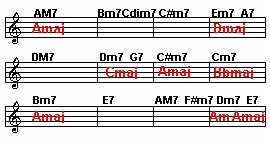Scroll through the lesson and click on notation/video/audio links to load the interactive players.
Please subscribe to get full access to all lessons for only $7.95/month PLUS 1 week free trial.

Riff Interactive lessons are
LESS expensive and
MORE interactive than alternatives!
More Info
|
|

Jam Sessions - Smooth Jazz
Style
Lesson 9 - Jam in A
Maj
Lyle:
This lesson is based off a 12 bar jazzy/blues progression. It is in the key of A
but in a couple places it switches keys. Here's the chord chart and jam track:
chord
chart

Lyle:
Here's how you can play the chords for this progression and one example of how
to play the rhythm guitar part using these chords:
zz: Looks like
your playing your Les Paul tonight:)
Lyle: Going for the
sustain!
Lyle: The whole chord progression is a
handfull.
zz:
Nice axe!
Lyle:
Thanks
Lyle: Let's look at soloing over the
progression.
Lyle: Since the progression is in the key of A,
you could play the A major pentatonic while improvising:
Andy: What
would this progression be called?
II-V-I?
Lyle: The progression starts in the I. The whole
progression is based off the simple I - IV - V theme.
Lyle: You could also use the A Major
scale:
Picky: What is
the difference in the A major and the A major pentatonic?
Lyle:
Good question.
Lyle: The major pentatonic has 5 scale tones, the
root, 2nd, 3rd, 5th, and 6, while the major scale has 7 tones, the root, 2, 3,
4, 5, 6, 7.
Lyle:
Let's look at the chord chart again:
chord chart 2

Lyle: During the 4th bar, the chords are now in
the key of D major. Em7 is the ii chord in D, A7 is the V chord in D. So this
means you need to change keys right here during this 4th measure to fit into the
new key - D major:
zz: How about E
dorian? would that work
Lyle: Yes, during the 4th
measure.
Lyle: Same things happens in the 6th bar, a ii -
V chord change (Dm7 to G7) in the key of C. So you have to change to the key of
C major just for the 6th bar:
Lyle:
You could use the D Dorian minor mode during the 6th
measure:
Lyle:
Remember, you can just jam around using the A major
pentatonic.
Lyle: Now let's learn the solo from the lesson
sample. The lesson sample starts off by playing a riff that is found again in
the last two bars of the progression. This is often called the "turnaround"
riff:
Lyle:
Here's the first 4 bars of the solo from the lesson sample. Notice in bar 4 it's
just a descending D major scale:
Lyle:
Here's the next 4 bars of the solo. Notice you'll be switching keys during the
Dm7 - G7 chords:
zz: Whats the
best way to learn these solos? They almost seem to much to handle in one
sitting. Suggestions?
Lyle:
Come back for several sittings :-)
Lyle: If everything was easy in one sitting, what
would be the fun of practicing?
Lyle: For each one of these TAB files, you can
click the loop button and have them play back over and over again, just like
having your own custom jam track.
Lyle: During the last 4 bars of the solo, you'll
start off with the Bm7 chord and playing riffs made right from the chord, then
switch to an E major pentatonic riff before coming to the turnaround riff again:
zz: I guess
your right......thats half the fun....practicing.
Lyle: Yes!
Lyle:
Remember, this whole progression is based off the key of A major, but watch out
for bar 4 and 6, where it changes to D major and then C maj. During the Cm7
chord try playing the C minor pentatonic or Bb major scale there. During the Dm7
chord in the last measure, try the A minor pentatonic or C major scale.
Lyle: That's it for this jam.
Enjoy! I'll see you next time -
Lyle
|
<< load notation from left
|
|
<< load audio from left
|
<< load audio from left
|